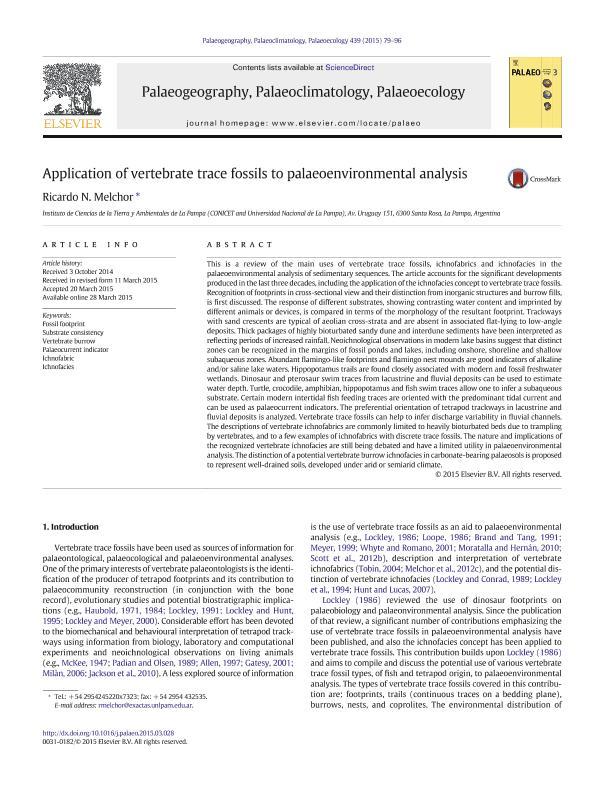Mostrar el registro sencillo del ítem
dc.contributor.author
Melchor, Ricardo Nestor

dc.date.available
2017-06-29T20:21:49Z
dc.date.issued
2015-12
dc.identifier.citation
Melchor, Ricardo Nestor; Application of vertebrate trace fossils to palaeoenvironmental analysis; Elsevier Science; Palaeogeography, Palaeoclimatology, Palaeoecology; 439; 12-2015; 79-96
dc.identifier.issn
0031-0182
dc.identifier.uri
http://hdl.handle.net/11336/19210
dc.description.abstract
This is a review of the main uses of vertebrate trace fossils, ichnofabrics and ichnofacies in the palaeoenvironmental analysis of sedimentary sequences. The article accounts for the significant developments produced in the last three decades, including the application of the ichnofacies concept to vertebrate trace fossils. Recognition of footprints in cross-sectional view and their distinction from inorganic structures and burrow fills, is first discussed. The response of different substrates, showing contrasting water content and imprinted by different animals or devices, is compared in terms of the morphology of the resultant footprint. Trackways with sand crescents are typical of aeolian cross-strata and are absent in associated flat-lying to low-angle deposits. Thick packages of highly bioturbated sandy dune and interdune sediments have been interpreted as reflecting periods of increased rainfall. Neoichnological observations in modern lake basins suggest that distinct zones can be recognized in the margins of fossil ponds and lakes, including onshore, shoreline and shallow subaqueous zones. Abundant flamingo-like footprints and flamingo nest mounds are good indicators of alkaline and/or saline lake waters. Hippopotamus trails are found closely associated with modern and fossil freshwater wetlands. Dinosaur and pterosaur swim traces from lacustrine and fluvial deposits can be used to estimate water depth. Turtle, crocodile, amphibian, hippopotamus and fish swim traces allow one to infer a subaqueous substrate. Certain modern intertidal fish feeding traces are oriented with the predominant tidal current and can be used as palaeocurrent indicators. The preferential orientation of tetrapod trackways in lacustrine and fluvial deposits is analyzed. Vertebrate trace fossils can help to infer discharge variability in fluvial channels. The descriptions of vertebrate ichnofabrics are commonly limited to heavily bioturbated beds due to trampling by vertebrates, and to a few examples of ichnofabrics with discrete trace fossils. The nature and implications of the recognized vertebrate ichnofacies are still being debated and have a limited utility in palaeoenvironmental analysis. The distinction of a potential vertebrate burrow ichnofacies in carbonate-bearing palaeosols is proposed to represent well-drained soils, developed under arid or semiarid climate.
dc.format
application/pdf
dc.language.iso
eng
dc.publisher
Elsevier Science

dc.rights
info:eu-repo/semantics/openAccess
dc.rights.uri
https://creativecommons.org/licenses/by-nc-nd/2.5/ar/
dc.subject
Fossil Footprint
dc.subject
Substrate Consistency
dc.subject
Vertebrate Burrow
dc.subject
Palaeocurrent Indicator
dc.subject
Ichnofabric
dc.subject
Ichnofacies
dc.subject.classification
Geología

dc.subject.classification
Ciencias de la Tierra y relacionadas con el Medio Ambiente

dc.subject.classification
CIENCIAS NATURALES Y EXACTAS

dc.title
Application of vertebrate trace fossils to palaeoenvironmental analysis
dc.type
info:eu-repo/semantics/article
dc.type
info:ar-repo/semantics/artículo
dc.type
info:eu-repo/semantics/publishedVersion
dc.date.updated
2017-06-29T13:59:13Z
dc.journal.volume
439
dc.journal.pagination
79-96
dc.journal.pais
Países Bajos

dc.journal.ciudad
Ámsterdam
dc.description.fil
Fil: Melchor, Ricardo Nestor. Consejo Nacional de Investigaciones Científicas y Técnicas. Instituto de Ciencias de la Tierra y Ambientales de La Pampa. Universidad Nacional de La Pampa. Facultad de Ciencias Exactas y Naturales. Instituto de Ciencias de la Tierra y Ambientales de La Pampa; Argentina
dc.journal.title
Palaeogeography, Palaeoclimatology, Palaeoecology

dc.relation.alternativeid
info:eu-repo/semantics/altIdentifier/doi/http://dx.doi.org/10.1016/j.palaeo.2015.03.028
dc.relation.alternativeid
info:eu-repo/semantics/altIdentifier/url/http://www.sciencedirect.com/science/article/pii/S0031018215001595?via%3Dihub
Archivos asociados
